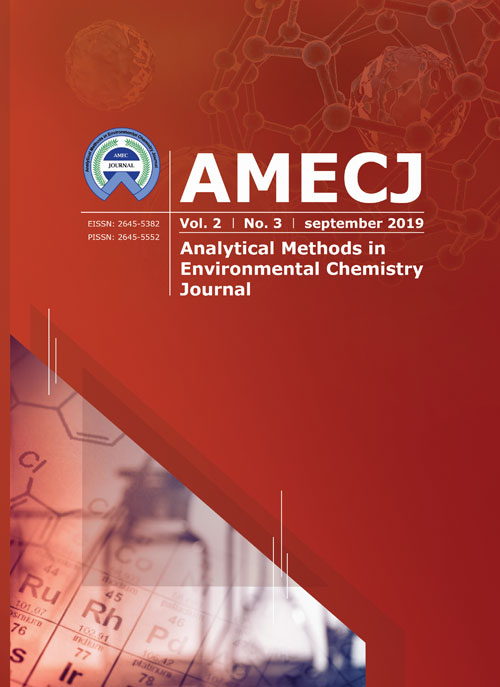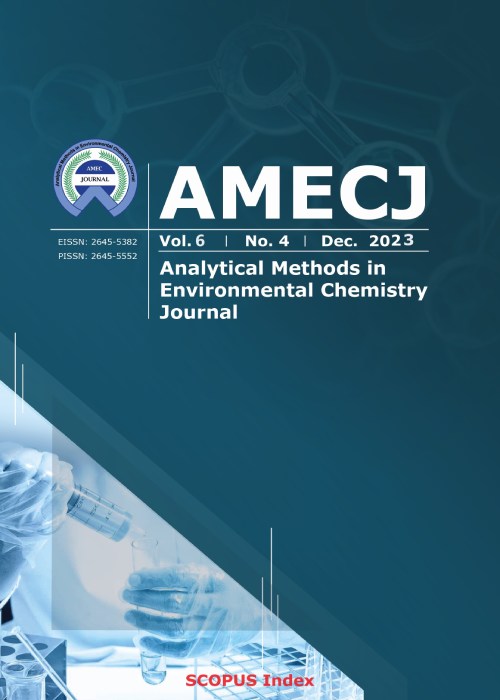فهرست مطالب

Analytical Methods in Environmental Chemistry Journal
Volume:2 Issue: 3, Sep 2019
- تاریخ انتشار: 1398/10/22
- تعداد عناوین: 7
-
Pages 5-126
Heavy metals and organic pollutants are ubiquitous environmental pollutants affecting the quality of soil, water and air. Over the past 5 decades, a lot of strategies have been being developed for treatment of polluted water. Strategies involving aquatic plant use are preferable to conventional methods. In this study, an attempt was made to provide a profound and brief review on latest and newest progresses in research and practical applications of phytoremediation for water resources with the following objectives: (1) to discuss the toxicity of chemicals pollution in water to plant, animals, and human health (2) to summarise the physicochemical factors affecting removal of toxic chemicals such as heavy metals and organic contaminants in aqueous solutions by aquatic plants; (3) to summarise and compare the removal rates of heavy metals and organic contaminants in aqueous solutions by diverse aquatic plants; and (4) to summarise chemometric models for testing aquatic plant performance. More than 20 aquatic plants specie have been used extensively while duckweed (L. minor), water hyacinth (Eichhornia crassipes), water lettuce (P. stratiotes) are the most common. Overall, chemometrics for performance assessment reported include: Growth rate (GR), Growth rate inhibition (% Inhibition), Metal uptake (MU), translocation/ transfer factor (TF), bioconcentration factor (BCF), Percent metal uptake (% MU), Removal capacity (RC) and Tolerance index (TI) while absorption rate have been studied using the sorption kinetics and isotherms models such as pseudo-first-order (PFO), pseudo-second-order (PSO), Freundlich, Langmuir and Temkin. Using modeling and interpretation of adsorption isotherms for performance assessment is particularly good and increases level of accuracy obtained from adsorption processes of contaminant on plant. Conclusion was drawn by emphesizing the gap in knowledge and suggesting very important future areas of research for scientists and policymakers.
Keywords: Chemical pollutants, Chemometrics, Constructed wetlands, Hydroponics, Macrophytes, Models, Toxicity, Water pollution -
Pages 39-50
An efficient method based on thiol functionalized mesoporous silica nanoparticles (HS-MSNPs) was used for extraction of lead ions (PbII) from urine and water samples by packed column micro solid phase extraction (PC-MSPE). By procedure, 15 mg of HS-MSNPs packed in syringe cartridges (SC, 5mL) with cellulose membrane and pH adjusting at 5.5-6.5. Then, the lead of urine and water sample was efficiently extracted on HS-MSNPs after pushing the plunger of a syringe. Finally, the Pb (II) was back-extracted with inorganic acid solution and the remained solution determined by electrothermal atomic absorption spectrometry (ET-AAS). By optimization conditions, the enrichment factor, LOD, linear range and RSD% was obtained 24.8, 0.04 μg L-1, 0.12-5.5 μg L-1 and less than 5%, respectively for 5 mL of urine samples. The validation was confirmed by spiking of real samples and using certified reference material (CRM, NIST) in water and urine sample.
Keywords: Lead, Human sample, Thiol-mesoporous silica nanoparticles, Packed column micro solid phase extraction, Electrothermal atomic absorption spectrometry -
Pages 51-66
In this study, the surface modification of graphene (SMG) was developed for efficient speciation and determination of chromium in water and wastewater samples. First surface of the graphene was modified with acid mixtures, potassium persulfate (KPS) in an alkaline media, tetra hydro furan (THF), Octadecyl amine and sodium dodecyl benzene sulfonate (SDBS) as synthesis. By procedure, the chromium ions was extracted from water/wastewater sample based on sulfonated and amine graphene (S-NG, N-NG) by suspension solid phase microextraction procedure (SMSPE). Hydrophobic ionic liquid ([HMIM] [PF6]) was used for separation graphene from 10 mL of waters. After shaking and centrifuging, the phase of Cr→ S-NG, Cr→N-NG was back extracted by 0.2 mL of HNO3 (0.4 mol L-1) and finally chromium concentration determined with electrothermal atomic absorption spectrometry (ET-AAS). The results showed, the sulfonated and amine graphene can successfully extracted Cr(III) and Cr(VI) from water and wastewater samples at pH=3.5-5.5 and pH<3, respectively. Also, the most Cr(VI) extracted by N-graphene at pH=2(NH3+→Cr2O7─). Under the optimal conditions, the linear range, limit of detection and preconcentration factor were obtained 0.02–2.4 µg L−1, 5.0 ng L−1 and 20.2 for 10 mL of water samples, respectively for Cr(III,VI) (%RSD<5%, pH=4). The validation of methodology for speciation of chromium was confirmed by spiking real samples.
Keywords: Chromium, Extraction, Graphene, Modified graphene, Sulfonated, Amidation, Environment sample -
Pages 67-78
In this research, the metal–organic framework (MOF) as a solid phase was used for separation mercury [Hg (II)] inhuman serum sample by ultrasound assisted- Ionic Liquid-solid phase microextraction procedure (USA- IL-μ-SPE). Mercury extracted from serum sample by [Zn2(BDC)2(DABCO)]n as MOF at pH=8. Hydrophobic ionic liquid ([BMIM] [PF6]) was used as solvent trap for Hg-MOF-NC from the sample solution. The phase of HgMOF-NC was back extracted by 0.5 mL of HNO3 (0.2 mol L-1) and finally mercury concentration determined with cold vaporatomic absorption spectrometry (CV-AAS) after dilution with 0.5 mL of DW. Under the optimal conditions, the linear range, limit of detection and preconcentration factor were obtained 0.02– 5.5 µg L−1, 6.5 ng L−1 and 9.8 for serum samples, respectively (%RSD<5%). The validation of methodology was confirmed by standard reference materials (SRM).
Keywords: Metal–organic framework, Ultrasound assisted -micro-solid phase extraction, Mercury, Serum samples, Cold vapor atomic absorption spectrometry -
Pages 79-88
Mercury as a hazardous material can be released in air and caused renal failure and CNS problem in humans. In this study, mercury vapor removed from air based on nickel-coated on multi-walled carbon nanotubes (Ni-MWCNTs) as a novel sorbent at room temperature. By procedure, amalgamation of mercury with Ni-MWCNTs was achieved by solid-gas phase removal method (SGPR). In bench scale set up, the mercury vapor generated and mixed with purified air with electro air cleaner and moved to sorbent at optimized flow rate. After thermal desorption of Ni-MWCNTs at 200 oC, the mercury vapor flowed to quartz glass cell with argon gas and determined by cold vapor atomic absorption spectrometer technique (CV-AAS). In optimized conditions, 25 mg of Ni-MWCNTs and MWCNTs with different size from 30-100 nm was used and the adsorption capacity of sorbents was obtained 194 mg g-1 and 64 mg g-1, respectively. The efficient recovery was obtained at optimized conditions such as, temperature of 25-40 and flow rate of 200 mL min-1. Due to results, the surface of Ni-MWCNTs had good potential for removal of mercury vapor from the air and can be used as a low cost and efficient sorbent in industrial workplace
Keywords: Mercury, Removal from air, Nickel coated on multi-walled, carbon nanotubes, Adsorption, Solid-gas phase removal -
Pages 89-96
The ubiquity of microplastics in the environment is a novel problem to scientist, public media, governmental and non-governmental organization. The major problem is from the difficultness in removing them from the ecosystem. Elsewhere studies are being conducted while in Nigeria studies are relatively lacking. Production (10.3 %) and consumption (6.5 %) of plastics is on the increase annually, thereby, causing an increase in the amount of plastic waste generated annually. This is turn may potentially causing high microplastics pollution in Nigeria. Many reports have shown that microplastics could cause harm to man, animals and plants and exposure (or ingestion) could come from air, water and soil. Few studies have been conducted in Nigeria and reports have suggested high abundance of microplastics in Nigeria freshwater system. Following these observations, there is a clear need for more detailed studies focusing on the quantitative and qualitative determination of occurrence of microplastics in Nigeria ecosystem. Finally, from such studies, data generated will provide insight and understanding into the extent of microplastic pollution in Nigeria. Furthermore, the data will be important not only for both remediation and minimization of effects, but could be employed in averting occurrence through policies such as ban on some types of plastic uses in Nigeria. In this study, four manually generally microplastic types (PVC, acrylics, polyesters, silicones) were evaluated for heavy metals (Pb, Cd, Hg, and As) adsorption at optimized pH by ETAAS.
Keywords: Environment pollution, Human health, Micropollutants, Heavy metals, Nigeria, Soil, Water pollution -
Pages 97-126
Heavy metals are vital and necessary in our daily lives. Moreover, if the amounts of heavy metals are more than the acceptable amounts (mentioned by WHO) in soil, water, and air, indeed, they cause a lot of diseases in human bodies. Therefore, monitoring and measuring the amounts of heavy metals which are arduous and difficult are so important. In this review paper, a lot of studies which have been carried out on the determination and quantification of heavy metals in human bodies, soil, and water are considered. Moreover, the effect of toxicity of each heavy metal on human health is assessed. According to WHO, EPA, NIOSH, ACGIH, and clinical chemistry, determination of heavy metals such as Cd, Pb, Zn, Hg, Cu, Mn is very important in human body and Environmental matrixes. For example, the range concentration of heavy metals in human body such as, cadmium is about 0.3 to 0.98, and for cooper, it is about 0.01 – 1.107 ppm. In addition, most obtained results demonstrate that the lowest and highest range concentration of heavy metals in blood of human body has been equal to 0.56–8.78 ppm and 0.08 – 4.67 ppm respectively. Finally, in this review paper, the approaches of quantification of heavy metals using atomic absorption spectrometry, gas chromatography, inductively coupled plasma mass spectrometry etc. in human bodies, water, and soil are assessed.
Keywords: Heavy metals, Toxicity, Biological, Environmental matrix, Analytical methods, Nanotechnology


